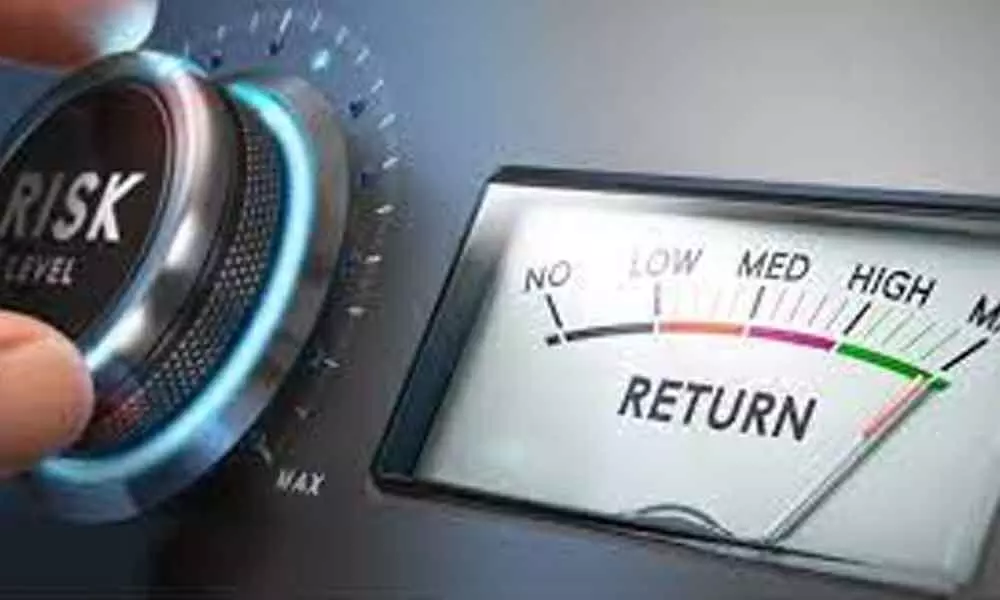Live
- MyVoice: Views of our readers 27th July 2024
- Trump will need a new attack plan for younger Kamala is
- Jagan claims innocence after ruining AP economy
- Kamala Harris to take the bull by the horns
- Myanmar floods displace 1,30,000; Magway region most affected
- Flashback: PM Modi's emotional encounter with wounded soldier during Kargil war
- All Party Committee Visit Pedda Vagu Bridge Construction in Ieeja Municipality
- Limited seats available for admission to Future-ready Career Programmes in NIIT University (NU)
- Women’s Asia Cup: BCCI Secretary Jay Shah pens congratulatory message to ‘finals-bound’ Team India
- 3.16 acres of land originally purchased for Rs 1 in 1935: Siddaramaiah on MUDA land case
Just In
Be aware of the risk in your investment


Representational Image
When return expectations turn into greed, the risk assessment is diluted leading to indiscipline. The investors need to stick to their risk profile for better returns
Recently one of my friends called me to find out the options to invest his dad's retirement corpus. He was unimpressed with the returns from the fixed income and similar assets that are currently available. Since it's a larger corpus, I'd suggested about diversifying into multiple assets to get a better risk adjusted returns. But what caught my attention was the raw pursuit of returns and especially in this low interest rate environment.
While I wanted to warrant his wishes, I was searching for a right analogy to explain the risk quotient he was leading into. The discussion veered to a car I recently drove. We were talking the pros and cons of it and then he said that the only shortcoming of that model is the less-efficient braking system at high speeds. So, he felt that one needs to be vigilant while taking higher speeds in that vehicle.
It struck me on how we make decisions about handling or managing risk. The risk of higher speeds persists despite a better braking system, but if we were to end up with a better car then we invariably hit higher speeds, thus increasing the risks again. Risk in simple terms is nothing but uncertainty or a probability of an event leading to a loss. Unfortunately, risk is more to do with how we perceive than what it actually it is. So, what's riskier for me mayn't be the same for another person. This dichotomy of understanding leads us to make choices that turn harmful for our investment journey.
This is well explained in the risk compensation theory which suggests on how typically people adjust their behaviour in response to 'their' risk perception. This leads to being more careful when sensing higher risk and less careful when one feels protected or finds less risk. This could lead to lower net benefits of safety interventions than usually thought. This reduction of predicted benefits arising out of regulations made to improve safety is referred to Peltzman's effect named after Sam Peltzman who in 1975 published a paper on how the improved safety regulations haven't reduced the highway deaths.
Seatbelts and Anti-Lock Breaking Systems (ABS) were designed to provide greater safety for drivers. But research found that the drivers of vehicles with ABS tend to drive faster, follow closer and brake later thus negating the benefits of road safety otherwise achieved with the system. A 1994 study of people who both wore and habitually didn't wear seatbelts concluded that drivers were found to drive faster and less carefully when belted.
As per the behavioural theory, risk seeking is an attitude where a person is inclined to take less-certain activities in lieu of more certain ones. This acceptance of greater risk and uncertainty in exchange for the potential higher returns would often result in undesirable outcomes. Risk seekers, though have a high level of risk tolerance which is not the case with most investors. The concern here is the side stepping the comfort zone in chasing for higher returns particularly in these desperate situations.
Risk-seeking tends to be on rise during bull markets as investors see their targeted returns reaching easily and at times earlier than planned. At these times when the drawdowns are minimal and shallow, the guard of general public is also lowered due to the buoyancy in the markets. As return expectations slowly cross to greed, the risk assessment is diluted leading to indiscipline.
This is why I would like to define the investment objective at the beginning and thus arrive at the return expectations. What most investors do is take this rationale inversely, they would approach an investment with a certain return expectation. When an investment objective is defined well then the risk associated would be firm and clear. That way investors wouldn't be making wrong choices in investing. Also, one has to stick to their risk profile and not be carried away with the market conditions.
(The author is a co-founder of 'Wealocity', a wealth management firm and could be reached at [email protected])

© 2024 Hyderabad Media House Limited/The Hans India. All rights reserved. Powered by hocalwire.com






